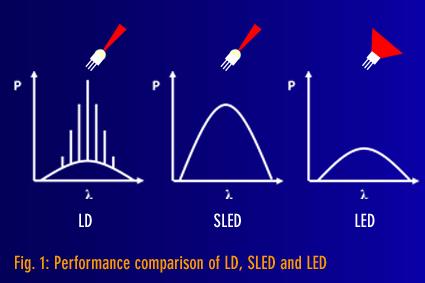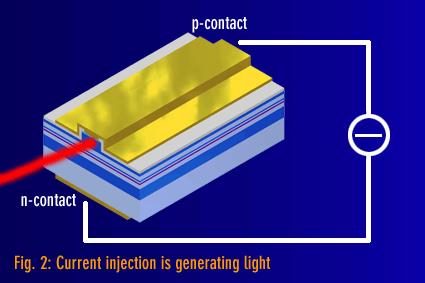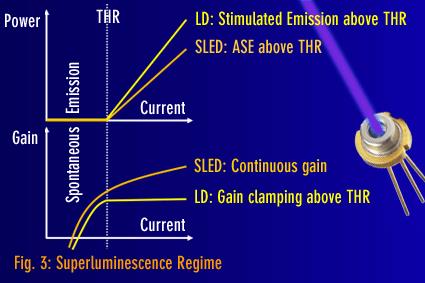LD和LED是人们司空见惯的两个英文缩略词, 尤其是光电子专业的人对它们尤其不陌生. 但是我们在光通信和传感领域也会频繁地接触SLED这种产品, 它们之间有着怎样的联系, 又有怎样的区别呢?
SLED, 字面理解是超级LED, 抑或超亮度LED. 它和LD/LED一样都是基于半导体工艺制作而成. 超亮度是指它的发射功率非常高, 通常LED的入纤功率只有几十至数百微瓦, 而SLED可以达到几乎与LD齐平的水准, 轻松获得数十毫瓦的入纤功率. 究其原因是SLED的光束发散类似LD非常小, 耦合效率高. 另外SLED的光谱宽度却是具有LED的光谱特点, 非常广的有效谱宽, 高效的耦合效率也带来了谱密度的极大提升. 因此在传感和谱线测量领域有着更为广泛的应用.
下图是LD/LED/SLED的光谱和光束特性示意图, 可见SLED结合了LED和LD各自的优点. 从工作机理上说, LED发光是属于自发辐射模式, 而LD是受激辐射, SLED属于放大的自发辐射, 因此在空间相干性上, SLED相干长度较LD更短. 而在光的偏振度方面, SLED的偏振度介于LD和LED之间, 属于部分偏振光, 而且偏振光成分较高, 会引起光路中的偏振相关效应.
更为详细的关于三者之间的相同与差异描述, 请查阅以下英文介绍.
Superluminescent Emitting Diodes (SLEDs, SLDs) are semiconductor devices that emit broadband light through electrical current injection. SLEDs are a hybrid between LEDs, which emit broadband light in all directions, and semiconductor laser diodes, which emit narrowband light with a well-defined laser beam. In this sense, SLEDs can be understood as broadband laser diodes with a beam-like output.
Broadband means that SLEDs emit an optical spectrum that is broad in the wavelength or frequency domain. The spatial domain is correlated to the frequency domain through the Fourier transform. A light source that is broadband in the frequency domain is therefore narrowband in the spatial domain, meaning it is having a short coherence length. In this sense, SLEDs can be understood as incoherent laser diodes.
Light from any light source can interfere with light from the same or another light source, but only within its coherence length. Reflections from surfaces, which are never perfectly flat and even, cause so-called “speckles” when the path differences between the interfering light waves are smaller than the coherence length of the light. Speckles are random dark and white interference patterns that are perceived as noise. Narrowband laser diodes typically generate speckle noise because of their large coherence length. In this sense, SLEDs can be understood as speckle-free laser diodes.
Broadband Light Generation in SLEDs
When an electrical forward voltage is applied an injection current across the active region of the SLED is generated. Like most semiconductor devices, a SLED consists of a positive (p-doped) section and a negative (n-doped) section. Electrical current will flow from the p-section to the n-section and across the active region that is sandwiched in between the p- and n-section. During this process, light is generated through spontaneous and random recombination of positive (holes) and negative (electrons) electrical carriers and then amplified when travelling along the waveguide of a SLED.
of a positive (p-doped) section and a negative (n-doped) section. Electrical current will flow from the p-section to the n-section and across the active region that is sandwiched in between the p- and n-section. During this process, light is generated through spontaneous and random recombination of positive (holes) and negative (electrons) electrical carriers and then amplified when travelling along the waveguide of a SLED.
The pn-junction of the semiconductor material of a SLED is designed in such a way that electrons and holes feature a multitude of possible states (energy bands) with different energies. Therefore, the recombination of electron and holes generates light with a broad range of optical frequencies, i.e. broadband light.
Comparison to LEDs and Laser Diodes
A broad range of possible energy transitions is something that also applies to a semiconductor laser, for example a Fabry-Perot (FP) laser diode (LD), or to a light-emitting diode, a LED.
FP laser diodes use the broadband gain of the semiconductor material, an optical waveguide and reflecting facets of the LD chip to build a laser cavity (resonator). Starting from spontaneous emission that is amplified along the waveguide of the LD, light travels back and forth (multiple roundtrips) inside the laser cavity, resulting in constructive amplification of cavity modes through stimulated emission. Consequently, the optical spectrum of a FP laser diode exhibits a comb of distinct longitudinal modes of the laser cavity.
SLEDs exploit the process of amplified spontaneous em ission (ASE) where light of spontaneous emission is amplified only in a single pass through an optical waveguide as compared to amplification over multiple roundtrips in an LD. For this reason SLEDs typically have lower output powers for the same electrical drive current as compared to LDs, which also means that their wall-plug efficiency is lower. Furthermore, any kind of optical cavity is avoided in a SLED, resulting in a broadband spectrum with no or little amplitude modulation (spectral ripple).
ission (ASE) where light of spontaneous emission is amplified only in a single pass through an optical waveguide as compared to amplification over multiple roundtrips in an LD. For this reason SLEDs typically have lower output powers for the same electrical drive current as compared to LDs, which also means that their wall-plug efficiency is lower. Furthermore, any kind of optical cavity is avoided in a SLED, resulting in a broadband spectrum with no or little amplitude modulation (spectral ripple).
LEDs do not feature any optical waveguide and are therefore not edge-emitting devices with a “laser beam” like LDs or SLEDs. Instead, LEDs emit in all directions light from spontaneous emission only (as compared to ASE). The total output power of LEDs can be considerably high, however due to the wide emission angles the optical power density (intensity) is lower as compared to SLEDs or laser diodes. For the same reason, coupling into single-mode optical fibers is rather impractical with LEDs and coupling efficiencies are very poor. LEDs produce light with an optical spectrum that might be even wider than that of a SLED because the process of amplified spontaneous emission along the waveguide results in spectral narrowing.
Summary
The following table summarizes and compares the optical properties of LEDs, SLEDs and LDs.
| LED | SLED | LD | |
| Principle of Light Generation | Spontaneous Emission | Amplified Spontaneous Emission | Stimulated Emission |
| Optical Spectrum | Broadband | Broadband | Narrowband or multiple Fabry-Perot modes |
| Total optical output power | Medium | Medium | High |
| Optical power density | Low | Medium | High |
| Optical waveguide | No | Yes | Yes |
| Light Emittance | All directions | Divergence-limited | Divergence-limited |
| Spatial coherence | Low | Medium | High |
| Coupling into single-mode fibers | Poor | Efficient | Efficient |
| Temporal coherence | Low | Low | High |
| Generation of speckle noise | Low | Low | High |
Copyright © 塑料光纤测试仪/MPO极性测试仪 版权所有 沪ICP备13024891号-5
全国服务电话:021-57733732 传真:021-57733732
公司地址:上海青浦区练东路3号

 在线客服
在线客服
